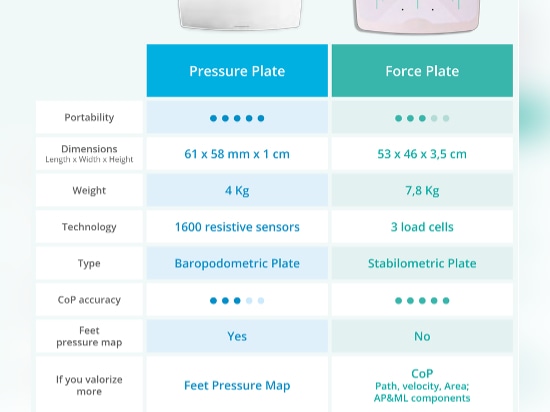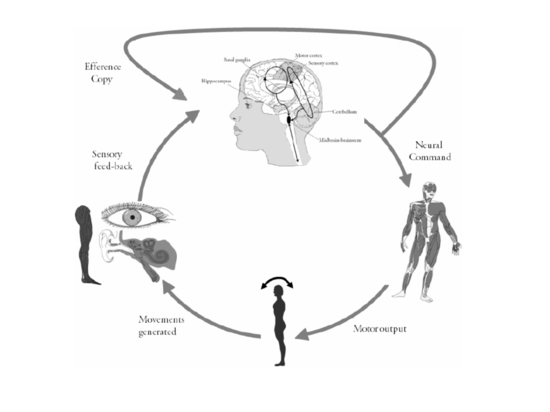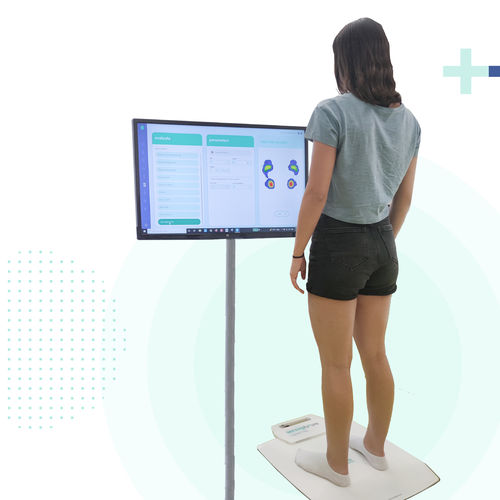
#Product Trends
What is the difference between force platforms and pressure platforms?
Both platforms measure different biomechanical characteristics. However, it’s easy to get pressure confused with force, and vice-versa
What is the difference between force platforms and pressure platforms?
1. The science behind
Both platforms measure different biomechanical characteristics. However, it’s easy to get pressure confused with force, and vice-versa:
• The pressure platform measures the plantar pressure distribution, obtaining the plantar pressure map, similar to a heatmap of the foot.
• The force platform measures the magnitude and direction of the resulting force, independent of the contact area, obtaining the resulting vector from the ground reaction force.
What is force and how to measure it?
According to Newton’s second law of motion, the net force is equated to the product of the body mass times the acceleration (Forcenet = mass x acceleration), in which the net force is the vector sum of all acting forces.
When using a force platform, it measures the reaction force exerted by the body on the supporting surface, usually the foot sole. This force is also known as ground reaction force, which correspond to the sum of all the acting force on the plantar surface (Figure 1). Therefore, it represents all the muscle and gravitational forces acting at a period of time [1].
Figure 1 – Ground reaction force [1].
Force platforms usually consist of a set of force transducers located under the corners of a solid plate, or in a triangle shape. There are various types of force transducers commonly found in these platforms, such as strain gauge, piezoelectric sensors and capacitance gauge load cells. Although the technology used in all these sensors is different, they all measure force by observing electrical current changes as force is applied. The electric output is then translated into a Newton value by means of the platform’s calibration. In addition, force platforms provide location of the point of application of the ground reaction vector on the plate – the center of pressure (CoP), by knowing the force measure on each transducer and its distance to the plate’s orthogonal reference frame [2].
On the other hand, it provides little information on how the plantar surface of the foot is loaded with respect to the supporting surface. That’s where the pressure platform solutions enter.
What is pressure and how to measure it?
By definition pressure is the physical quantity of force applied over a certain area (Pressure = Force / Area), i.e., the force per unit area over a surface in a direction perpendicular to that surface. The SI unit of pressure is Pascal, but plantar pressure is commonly described in kilopascal (kPa), Newton per square centimeter (N/cm2) or grams per square centimeter (g/cm2).
There is different technology that can be used to measure pressure, such as resistive, piezoresistive, capacitive and strain gauge sensor technologies. All these sensors provide an electrical signal output (voltage or current) when a deformation of the isolator material occurs. For example, a resistive sensor measures the resistance of conductive foam between two electrodes, when under pressure (Figure 2). Therefore, pressure can be derived by knowing the material deformation properties [3].
Figure 2 – Diagram of a typical force sensing resistor [3].
Pressure platforms are composed by matrices of these sensors embedded in rigid platforms. In this way, the whole plantar surface can be evaluated, by obtaining plantar pressure distribution information. In addition, the vertical component of the ground reaction force can be obtained through the summation of all the sensors bearing weight and thus the center of pressure position (similarly to force platforms). Consequently, the obtained CoP may be less accurate, due to sensor size and spatial resolution (number of sensors), but still allows pressure platforms to provide valid and usable CoP data for various circumstances.
Nevertheless, both pressure and force signals can be influenced by several aspects, such as linearity, hysteresis, frequency sampling and calibration process [1].
2. Baropodometric versus Stabilometric
As mentioned, it is possible to get different data from the two platforms, which leads us to two terms widely used when describing them – baropodometry and stabilometry.
Baropodometry is the study of the pressure that acts between the plantar surface of the foot and the support surface, using a pressure platform. This allows an objective assessment of plantar pressure distribution, as shown in Figure 3 - Left. While stabilometry is the objective study of body sway during quiet standing, conventionally by means of force platforms. During an upright body position, it is possible to quantify the small corrections that are performed to oppose the destabilizing effect of gravity [4]. This stabilization of the body is visible in the center of pressure trajectory, as displayed in Figure 3 - Right. On the other hand, pressure platforms can also give this information, but as stated before, usually with less accuracy, which means that force plates are capable of detecting smaller changes of sway.
Figure 3 – (Left) Plantar pressure map example. (Right) Statokinesigram graph example (CoP trajectory).
3. Application fields. Which platform do I need?
Pressure platforms allow an objective assessment of plantar pressure distribution, essential for the detection and identification of factors that trigger foot injuries and, consequently, the musculoskeletal system. From pressure data it is possible to identify disproportional pressure distribution and/or abnormal peak pressure values. Thus, it allows understanding and quantifying the biomechanical defects of the foot and verifying the evolution of the patient during the treatment or if it is necessary to modify it.
Force platforms are most often used to monitor small changes of sway, which can be useful to evaluate postural control and balance in specific fields that require such high sensitivity. For example, for athlete screening and lower limb and balance training programs to help athletes return to play, scientific research centers that require high precision measurements, and clinic practitioners that want to have a more accurate CoP [5].
Sensing Future has currently on the market two type of platforms, a pressure plate and a force plate, with the characteristics illustrated in Figure 4.
To sum up, if you valorize more load distribution, load transfers and pressure distribution, then the pressure plate is probably the right choice. On the other hand, if you are looking for balance assessment with a gold standard equipment and high CoP data precision is mandatory, the force plate is the right option.
Figure 4 - Pressure plate and force plate main characteristics, by Sensing Future Technologies.
If you need help about which platform is more appropriate for your practice:
- Send us an email: info@sensingfuture.pt
- Ask for a quotatio: https://www.physiosensing.net/quotation-request
Bibliography
[1] N. Guldemond, “‘Plantar pressure measurement’ in Plantar pressure, diabetes and amputation: studies on etiological, diagnostic and therapeutical aspects,” 2007, pp. 27–68.
[2] H. D. Staff, “So what exactly is a force plate?” https://www.hawkindynamics.com/blog/what-is-a-force-plate (accessed Mar. 03, 2021).
[3] A. H. A. Razak, A. Zayegh, R. K. Begg, and Y. Wahab, “Foot Plantar Pressure Measurement System: A Review,” Sensors (Basel), vol. 12, no. 7, pp. 9884–9912, Jul. 2012, doi: 10.3390/s120709884.
[4] F. Scoppa, M. Gallamini, G. Belloni, and G. Messina, “Clinical stabilometry standardization: Feet position in the static stabilometric assessment of postural stability,” Acta Medica Mediterranea, vol. 33, May 2017, doi: 10.19193/0393-6384_2017_4_105k.
[5] “The Science of Force Plates and Pressure Mapping,” Freelap USA, Dec. 18, 2015. https://www.freelapusa.com/the-science-of-force-plates-and-pressure-mapping/ (accessed Mar. 03, 2021).
Cláudia Tonelo
Sensing Future Technologies
![Figure 2 – Diagram of a typical force sensing resistor [3].](https://img.medicalexpo.com/images_me/projects/images-om/36387-16448655.jpg)
![Figure 1 – Ground reaction force [1].](https://img.medicalexpo.com/images_me/projects/images-om/36387-16448657.jpg)








